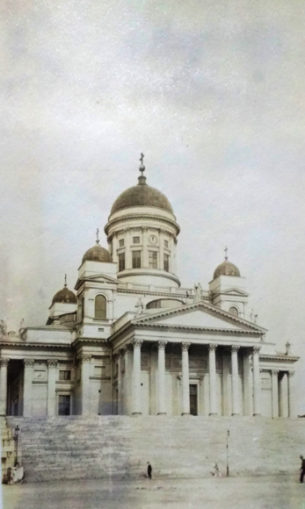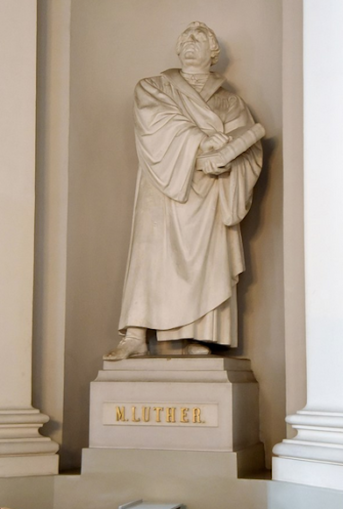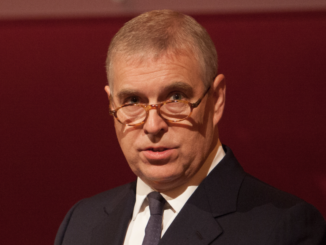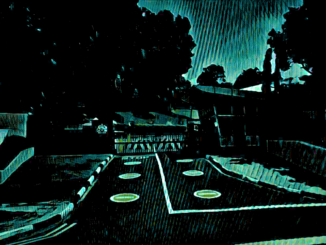From Helsinki Central Station, a five-minute walk takes one past the Ateneum and along Ateneuminkuja and Yliopistonatu to Senate Square, at the north end of which and up some steps sits Helsinki Cathedral. Billed as Carl Ludvig Engels’ grand neoclassical design topped with an iconic green dome, it was built between 1830 and 1852 replacing the Ulrika Eleonora Church of 1727, named after its patron Ulrika Eleonora, Queen of Sweden.

© Always Worth Saying, Going Postal 2022
Rather than a basilica, the cathedral is a Greek cross symmetrical in all directions with four faces, and a smaller dome at each corner. Each face has a similar neo-classical colonnade. To the south, a straight line runs to Satama harbour where international ferries still tie up and from where our mystery posh family of mystery photographs will have arrived. Originally named after Russian Tzar Nicholas I, with an altarpiece donated by the Tsar himself, by the time our mystery album family visited, Finland had become an independent country and the building had been renamed Helsinki Cathedral Great Church. Added to which, it is Lutheran not Orthodox.
Statues of the apostles stand around the roof armed with their symbols. Philip holds an open book, John the Apostle, a cup. The interior is plain with the only painted and gilded decoration being the Tzar’s Carl Timoleon von Neff’s depiction of The Descent of Jesus From The Cross. Statues inside include M. Agricola and Martin Luther. The former Augustinian monk is appropriately represented hammering a Bible.

Helsinki Lutheran Cathedral, Finnland,
Diego Delso – Licence CC BY-SA 3.0

Statute of Martin Luther, Helsinki Cathedral,
Bahnfrend – Licence CC BY-SA 4.0
Senate Square is the oldest part of Helsinki. On its western side sits the University of Helsinki which was constructed 1832. The university was originally founded in 1640 in Turku as the Royal Academy of Abo – the Swedish name for Turku. It is the oldest and largest university in Finland. As every Puffin knows, following the great fire of Turku in 1827 the university was moved to Helsinki (which was the new administrative capital of Finland) and became the ‘Imperial Alexander University in Finland’ named after patron Tzar Alexander I. This structure was also designed by Carl Ludvig Engel and was completed in 1832. The plan was to educate the bureaucrats and civil servants that would become Finland’s new administrative class.

The main building of the University of Helsinki,
Roger W – Licence CC BY-SA 2.0
This statist theme continued after independence in 1917 as the university’s academics were central in defining both the new nation-state and, after the Second World War, a Finnish welfare state.
Today there are 11 faculties and almost 40,000 students spread across four different campuses. Reference to their website shows that one can enrol in European and Nordic Studies for 13,000 Euros a year. Although the casual Puffin may think that Nordic refers to no more than iron ore railways, Vikings and tall girls with blonde hair, there remains a statist regional political philosophy resonant of the newly independent Finland over a century ago. According to wiki;
The traditional Nordic belief that the state was not inherently hostile to the well-being of its citizens, but could intervene benevolently on their behalf. According to some social historians, the basis of this belief was a relatively benign history that had allowed the gradual emergence of a free and independent peasantry in the Nordic countries and had curtailed the dominance of the nobility and the subsequent formation of a powerful right-wing.
The journey has not been smooth. On leaving Imperial Russia, a three-month-long civil war broke out between Whites (anti-communist) and Reds (communist). The south of Finland was controlled by the Reds with the north in the hands of the Whites and their Swedish and German allies. Thirty-six thousand perished in combat or in prison camps before a White victory which saw the Finns passing from the Russian to the German sphere of influence. By May 1918 the parliament building (pictured below) held a conservative monarchist senate led by J K Paasikivi.

© Always Worth Saying, Going Postal 2022
The eastern side of Senate Square is defined by a ‘government palace’ that was originally the senate building but which is now prime ministerial and cabinet offices. In 1931, a newer senate was built beside the old railway sidings on the far side of Central Station. It is very similar to the university building opposite but can be distinguished by a central dome, presumably the roof of a debating chamber.
The statue to the left is of Tsar Alexander II, erected in 1894 to commemorate the 30th anniversary of Finnish devolution prior to which the country had been a Russian Grand Duchy with the Tzar ruling as a Grand Duke. According to Wiki,
“Alexander II had re-convened the Diet of Finland and initiated several reforms increasing Finland’s autonomy within the Russian Empire, including the establishment of its own currency, the Finnish markka.”
As well as being Tsar during the Crimean War, Alexander II (1818-1881) was King of Poland, sold Alaska to the Americans and emancipated the lower orders by abolishing serfdom. As further proof, if it were needed, that you can’t please everybody, Alexander was plagued by assassination attempts.
A railway line was blown up in anticipation of the passing of the royal train. His dining room was destroyed in an explosion. When his horsedrawn carriage, 5 Cossack guards and two sleds were ambushed in the streets of St Petersburg, he survived the attack but made the mistake of stepping out of his bulletproof carriage (a gift from Napoleon III), whereupon a second bomber took the opportunity to throw an explosive. Rushed to a nearby palace, he died there of his wounds.

Набережная Екатерининского канала 1 марта 1881 года,
Anonymous Russian painter – Public domain
Your humble author pushed his analytic skills to the limit trying to understand the Tzars eight children but can’t quite work out their peerage. Two of them married the same Princess of Denmark and one married another Princess of Denmark and Greece (NB Prince Philip was a Prince of Denmark and Greece). Another married a Saxe-Coburg-Gotha (Queen Elizabeth II of the House of Windsor, not its real name, is properly a Saxe-Coburg-Gothe). One more married a Hesse (Prince Philip’s mother was a Hesse).
Sufficient to say, Alexander II is bigly related to our own Royal Family and, since he had another large family with his commoner mistress, is most probably related to the rest of us as well.
To the left of the statue is a side chapel of the main cathedral. Its mirror image at the western side of the steps serves as a bell tower.
Senate Square is a public space that hosts events such as a Christmas market. Also during the wintertime, in a not so ringing endorsement of Carl Ludvig Engels, as soon as it’s cold enough, they build an ice sculpture of the older city church from the same site.

Snow sculpture version of the Ulrika Eleonora Church,
Helsinki City Museum – Licence CC BY-SA 4.0
© Always Worth Saying 2022



